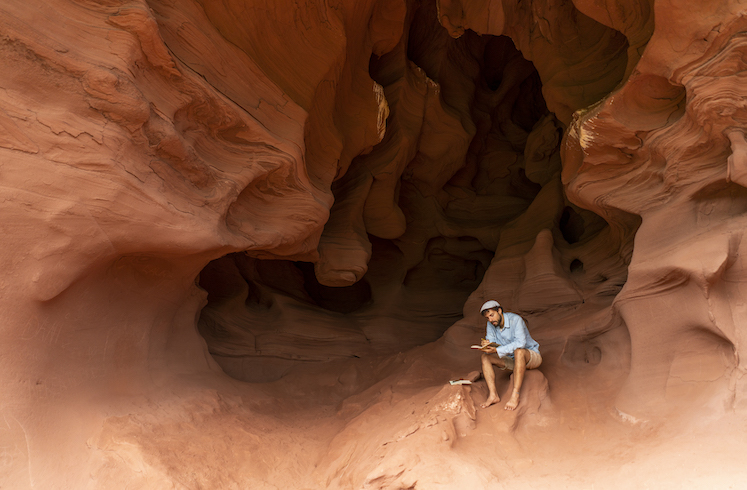Have an epic travel tale or know the best spots in France for brunch? Here’s how to get your work online so you can share what you know.
 Photo © Getty Images / Westend61
Photo © Getty Images / Westend61
- Master the basics of pitching
- Find the right website
- Find the right editor
- Notice the kind of content that your favorite websites publish
- What other skills do you need?
When I was first starting out as a travel writer at Outside magazine more than 20 years ago, print media outlets were still rather baffled by the internet. Were websites a place to post old, print stories? New stories? Short stories? Long stories? One thing was clear. An online-only story was inferior to a print story, because, as we all wondered back then, who would ever read anything online?
How quaint the predicaments of yesteryear now seem. We read entire books on our phones. Some newspaper travel sections now exist only online. Attitudes have long since changed, too. In 2000, you could hear the disappointment when you told a source the story would only appear online. Today, “will this be online?” is often the first question interview partners ask. And we all know why. Print-only stories end up in the recycling. Online stories live forever.
This is great news for new writers. The odds remain significantly higher for an online commission versus one in print. There’s simply much more real estate in the virtual world. In 2000, there were a mere 17 million websites. Today there are nearly 2 billion.
So, how do you pitch a story you hope will appear online? I spoke to four writers and editors working online today to get their tips. Here they are along with a few of my own.
Master the basics of pitching
Don’t be fooled. Despite the internet’s limitless hunger for content, it is not a space for stories that aren’t good enough for print, says Alison Osius, a travel editor at Outside. “Most online stories do tend to be shorter,” she says, “but the quality is evening out.” In other words, you still need a strong story no matter what. (To see the difference between an idea and a story, see my travel writing guide, available here.)
That means you need to have:
- A hook – the reason for doing a particular story now. A new kayaking tour is opening up; it’s the 100th anniversary of something; the World Cup is coming to town.
- A mission – how are you going to report this story or have you done it already? Will you hike up to 8 hours a day over high mountain passes to get to this new backcountry lodge? Did you spend three days in Sapporo checking out sake distilleries? Do you have three examples of new things happening in a neighborhood that make the area more interesting to travelers?
- A reason – why are you the best writer for this job? Have you published stories on other websites? Did you win the World Nomads Travel Writing Scholarship? Have you traveled extensively in Argentina? Speak Mandarin? Let the editor know.
Osius says even if you know your editor, it’s still worth including your bio anyway. “I forward pitches on to other editors all the time who might not know the writer,” she says.
Find the right website
Before you even pitch, find the right website for your story and make sure they haven’t covered your topic before, says Cameron Vigliotta, an editor at Forbes. You’re not going to have any luck pitching a story about backpacking through Laos on $5 a day to a magazine such as Robb Report that focuses on the ultra-wealthy. If a website has already covered scuba diving in an odd location like Arizona, the editor probably isn’t going to assign another odd scuba-diving story.
That said, don’t be afraid to adjust your idea to fit a website that might not seem obvious at first. Once, I really wanted to write about a “fondue king” in Switzerland. I could have pitched it to a food outlet but instead, I went straight to a skiing publication. What goes great with skiing? Melted cheese, of course! The editor agreed and off I went.
Find the right editor
Be sure you know who you’re pitching as well, says Kathleen Rellihan, a former travel editor at Newsweek and now a freelancer for National Geographic, Travel + Leisure and more. That means finding the masthead to get names of editors, going online to look at their social media accounts and surfing around on LinkedIn to gather other bits of intel that will tell you who assigns what. You don’t want your pitch about learning to hunt to land in the inbox of the person who edits fashion stories. “It shows your reporting skills,” she says. “If you can’t find the name of the right person to pitch, then you probably don’t have the skills you need for the story.”
Notice the kind of content that your favorite websites publish
Most online articles tend to be more “service” oriented, meaning they’re less of a tale and more of a mini guide pointing you to the best beaches, the weirdest restaurants or how to spend 36 hours in a city. There’s a lot of news out there, too. But unless you’re the first person to break a story, it’s probably best to find another way into it. If a popular national park is limiting the number of visitors this season, maybe you pitch a piece about “five other parks that don’t have limits.”
A lot of magazines will have editorial calendars available online that will give you an idea of what they’ll be working on, which means the doors for writing online are opening, too. Pitch your story about riding around Ireland on an electric bike for the “Green” issue and you’ll look like a pro.
What other skills do you need?
You don’t really need to know much about SEO or any back-end web development to pitch an online story, but Paulette Perhach, a writer who offers workshops and software for managing freelance assignments, adds you might want to add to your pitch some subheads you might use. Most online articles use them. (Notice how this article uses them). They give online readers a good point of entry.
It also helps if you’re good at taking photos or shooting short video clips, so say that if you can. Some sites don’t care so much about this but for others, not being able to provide “art” can be a dealbreaker. Even today at Outside, which has a budget to buy professional photos and videos, editors often want their writers to capture multimedia “assets” to augment whatever else they can find.
Lastly, keep your pitch short. Vigliotta says he wants no more than two paragraphs while Osius says no more than a page. “Editors are really, really busy,” Vigliotta says. “You’ll still hear 'no' a lot.” But keep after it. Good ideas are gold no matter where they land.
Related articles
Simple and flexible travel insurance
You can buy at home or while traveling, and claim online from anywhere in the world. With 150+ adventure activities covered and 24/7 emergency assistance.
Get a quote


No Comments